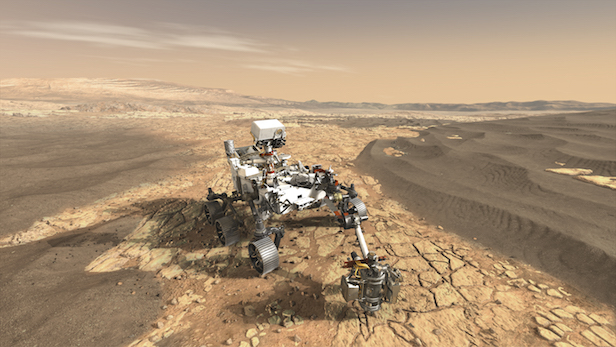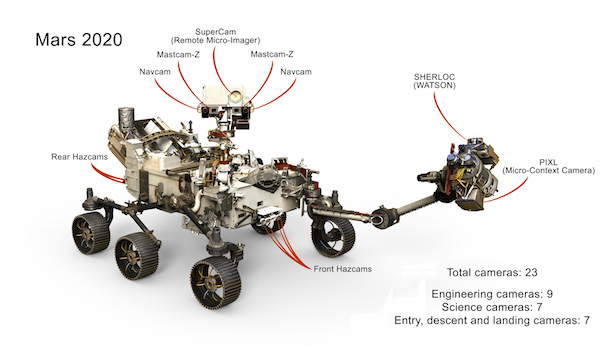New Mars 2020 rover will include twenty-three cameras
This will bring a new perspective to landing, navigating around and studying the surface of the Red Planet

The mission will ‘up the game’ in searching for signs of habitable conditions on Mars. Image credit: NASA/JPL-Caltech
All forms of technology have come along leaps and bounds in the last few decades, and that is reflected in the technological advances on Martian rovers. Having started with five cameras in 1997, the next rover to be sent to Mars in 2020 will now include a grand total of 23 cameras.
When NASA’s Mars Pathfinder christened the surface Mars with a man-made rover in 1997, it only had five cameras. There was two on the mast deployed from the lander and three on the Sojourner rover. It’s been 20 years since then, and cameras have transformed immaculately, becoming essentially ever-present. With photo sensors decreasing in size and increasing in quality, this is the reason why NASA is able to load up the Mars 2020 rover with 23 ‘eyes’. These cameras will create stunning panoramas, uncover obstacles, study the atmosphere and assist other scientific instruments onboard. For the first time, these cameras will also capture images of a parachute as it opens on another planet.
Some of the Mars 2020 cameras will include:
- Enhanced Engineering Cameras: These cameras will have colour, higher resolution and wider field of views than Curiosity.
- Mastcam-Z: This will be an amplified version of Curiosity’s Mastcam with a 3:1 zoom lens.
- SuperCam Remote Micro-Imager (RMI): Different to Curiosity’s ChemCam, this will be the highest-resolution remote imager and will have colour.
- CacheCam: This will be used to observe rock samples as the rover collects them.
- Entry, descent and landing cameras: Six cameras will document the entry, descent and landing on the Martian surface, including the first video of a parachute opening on another planet.
- Lander Vision System Camera: With the use of computer vision and a new technology called terrain relative navigation, this camera will guide the landing.
- SkyCam: This camera will study the clouds and the atmosphere using a suite of weather instruments facing the sky.
“Camera technology keeps improving,” said Justin Maki of JPL, Mars 2020’s imaging scientist and deputy principal investigator of the Mastcam-Z instrument. “Each successive mission is able to utilise these improvements, with better performance and lower cost.”
The cameras on 2020 will have superior colour and 3D imaging than the Curiosity rover, which currently has seventeen cameras. The rover’s main eyes, the Mastcam-Z, will be a vast improvement on Curiosity’s Mastcam. The Z stands Zoom, which is an aspect that will be added to the improved version of Curiosity’s Mastcam.

This wide selection of imagers will include nine engineering cameras, seven science cameras and seven entry descent and landing cameras. Image credit: NASA/JPL-Caltech
Mastcam-Z’s stereoscopic cameras will be able to examine Mars’ geological features in clearer detail now, as these cameras will support more 3D images. It is important to scout potential samples for a long distance away as well, as features like erosion and soil textures can be spotted at a distance of roughly a football pitch. These potential samples could serve as a benchmark to contextualize samples for future scientists. “Routinely using 3-D images at high resolution could pay off in a big way,” says Jim Bell of Arizona State University and 2020’s Mastcam-Z principal investigator. “They’re useful for both long-range and near-field science targets.”
The previously rovers, such as Spirit, Opportunity and Curiosity, were all equipped with engineering cameras for navigating the drives (Navcams) and avoiding hazards (Hazcams). These cameras produced one-megapixel images in black and white, but these new engineering cameras have been upgraded to twenty-megapixel colour images.
The lenses for these cameras will also include a wider field of view, which is vital for maximising efficiency when doing scientific analysis and collecting samples. Not only that, but the new engineering cameras will reduce motion blur, meaning the rover can take good quality images whilst on the move. “Our previous Navcams would snap multiple pictures and stitch them together,” says Colin McKinney of the Jet Propulsion Laboratory and product delivery manager for the new engineering cameras. “With the wider field of view, we get the same perspective in one shot.”
The main issue with all this upgrading of the rover’s cameras is that there’s much more data needed to be transferred into space. “The limiting factor in most imaging systems is the telecommunications link,” Maki says. “Cameras are capable of acquiring much more data than can be sent back to Earth.”
Much like camera quality has improved so has the compression process of files. On Spirit and Opportunity, the compression was done using the onboard computer. On Curiosity, much of it was done using electronics built into the camera, which allowed more 3D imaging, colour and high-speed video.
NASA has also improved by using orbiting spacecrafts at data relays, which began by using NASA’s Mars Odyssey orbiter. “We were expecting to do that mission on just tens of megabits each Mars day, or sol,” says Bell. “When we got that first Odyssey overflight, and we had about 100 megabits per sol, we realised it was a whole new ballgame.” With this concept, NASA plans to use the multiple spacecrafts in orbit around Mars to data relay of the 2020 information. These include the Mars Reconnaissance Orbiter, Mars Atmosphere and Volatile EvolutioN (MAVEN) and the European Space Agency’s Trace Gas Orbiter.
Keep up to date with the latest reviews in All About Space – available every month for just £4.99. Alternatively you can subscribe here for a fraction of the price!




